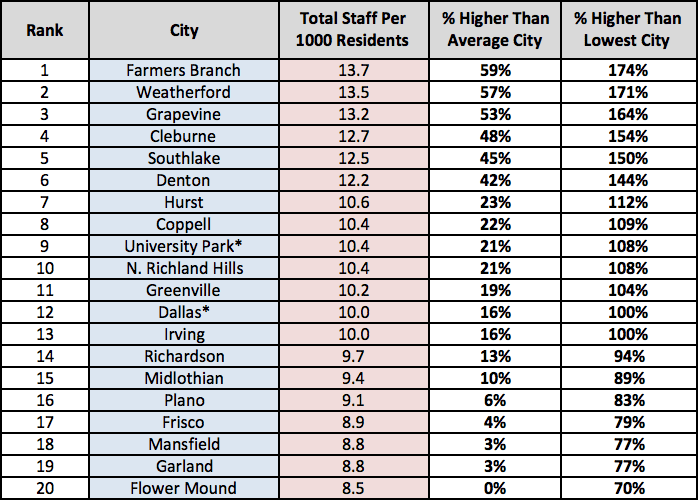The Metroplex Bureau of Empower Texans has uncovered an enormous inconsistency among the sizes of municipal bureaucracies across North Texas, with the largest cities in this category having more than twice the total number of employees per resident, when compared to others in the region.
In the following weeks, we will continue to release the results of our inaugural Local Government Snapshot analysis, which measures city spending, taxation, and debt levels across North Texas’ fifty most populous cities. Local officials and residents alike must be empowered with basic information in order to determine the appropriate size and scope of local government.
It’s unclear why staffing levels across municipalities vary this dramatically, raising legitimate questions as to whether or not elected officials are even aware of these revealing statistics.
They also raise concern as to whether or not cities with relatively higher levels of staff are being prudently managed in relation to their peers.
The largest single driver of operating expenditures in both the government and business sector is the cost of salaries and benefits for employees, a fact our analysis further substantiates. All but three cities with the highest number of staff are also among the top twenty highest spenders in North Texas. Higher staffing levels generally translate into higher total spending.
Although political rhetoric during budget negotiations often centers on adding or cutting police and firemen, only thirty to forty-five percent of a city’s total staff is categorized as public safety personnel. As a result, it’s likely that many cities with the largest payrolls would not need to reduce public safety or other core government services in order to save significant taxpayer money. The data suggests they should simply reduce the size of their total workforce, beginning with non-essential personnel. Reevaluating pension obligations and benefit packages are other areas that officials can reduce over-bloated staff-related costs.
Below are the top twenty North Texas cities with the highest total number of public workers, including public safety personnel, on a per resident basis. The analysis accounted for all full-time equivalents (FTEs), or staff employed on both a full-time and part-time basis.

Since local government reports are not entirely standardized, staffing levels across different categories could not be compared separately for this analysis. This presents significant analytical challenges.
For example, not all cities’ CAFRs contain identical staffing tables and statistics, including line items for police, fire, administrative, human resources, economic development and other individual categories. In order to conduct a deeper comparative analysis between specific categories, legislative reforms will be needed that require political subdivisions to standardize their CAFRs to increase transparency and public accountability.
Note: Each city’s 2014 Comprehensive Annual Financial Report (CAFR) provided all information used in our benchmarking analysis, including population figures.
*Cities that did not have their 2014 CAFR published online were included in our analysis using data from their 2013 CAFR.




